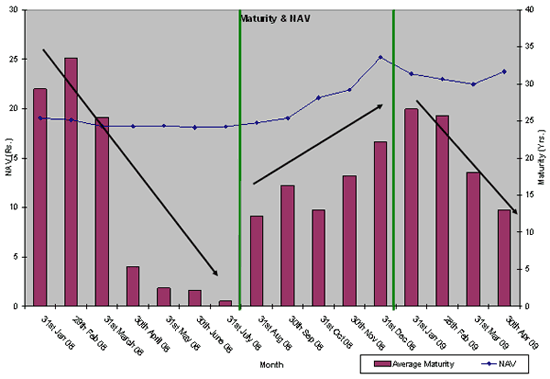In the previous article we had seen how lack of knowledge prevents us from taking the best decision even in case of a simple bank fixed deposit.
We had also asked about the similarity between a bank FD and a bond paper? Let us take this discussion forward today.
A debt paper is a paper issued by the borrower to the lender when he takes a loan from the lender. The debt paper mentions the amount of money taken as loan (par value of the paper), the period for which the loan is taken (term to maturity) and the rate of interest which the borrower will pay to the lender (coupon).
A bank FD also has the same three features. The only difference in the two is that while a debt paper is traded in the market, a bank FD is not tradable. However, that does not prevent us from taking the analogy forward.
In the previous article we had seen that by investing in Rs 100 in a one-year bank FD at 12 per cent in 2000 and then rolling it over for another year in 2001 and 2002 at 10 per cent and 8 per cent respectively, we earned Rs 30 in three years on our investment of Rs 100.
Just imagine what would have happened if we would have invested Rs 100 at 12 per cent in 2000 for a three year period? At the end of 2002, we would be having Rs 36 as interest as against Rs 30! On an investment of Rs one lakh this would mean a difference of Rs 6,000. And we have not used the effect of compounding yet (see related link: The magical power of compounding)
Similarly, we saw that by investing Rs 130 at 6 per cent for 10 years, we had lost on the rising interest rates. Again our money was growing at a slower rate than the rest of the market.
The lesson to be learnt here is that even when investing in a bank FD, we must have an idea on where the interest rates are headed.
As interest were expected to head down in 2000 and 2008 (these are the indications which we had spoken about in the earlier articles. Please read the article on repo, revere repo, CRR (see related link: Understanding repo, reverse repo and CRR), etc to understand how to read these indications), we would have been better off by investing in bank FDs of longer duration.
Similarly, from 2003 till 2008, we would have been better off by investing in bank FD with shorter duration as we would have got our money back faster, and every time the rates went up, we could get the benefit of these high interest rates.
True no one can time the markets.
In 2000 no one knew that by 2003 rates would have bottomed (reached their lowest and once again begun their upward journey), but it is safe to assume that it will take around 5 to 10 years for the rate cycle to reach where it was. Say, if we had invested in 2000 at 12 per cent for 10 years, then even today our money had been growing at 12 per cent!
Similarly, for somebody who invested from 2003, s/he could have easily invested for 10 years in 2008 at 10 per cent. But banks were also advertising 10 per cent in 1,000 days. Any seemingly logical investor would ask the question: why should I invest for 10 years at 10 per cent, when I am getting 10 per cent for less than 3 years?
Another question that should have been asked is: why is the bank paying 10 per cent for 2.7 years (1,000 days)? Reasons were a plenty for that, but had anybody invested Rs 100 in such a scheme, then s/he will face the problem, which we discussed in the previous article.
After 1,000 days, when any investor gets Rs 27.5 on her/his Rs 100 investment, s/he cannot reinvest the same at 10 per cent. Interest rates on FDs have already come down and are set to come down even more, and it still far from 1,000 days!
Thus a simple rule in investing in any fixed income investing (be it bank FDs or bonds) is that if interest rates are expected to head down, increase the duration of your investment and if rates are expected to rise, reduce the duration of your investments.
So in a falling interest rate scenario, buy long-term bonds and in a rising interest rate scenario, buy short-term bonds. Since we cannot buy bonds directly (we can actually, but we do not get into that right now), this analogy should be used to buy long-term and short-term bond mutual funds.
Thus we have understood that interest rates are critical for investing in fixed income investments. Let us see how to apply this bit of knowledge and see whether it really works!
A look at the chart below highlights what we have said above. The chart below is drawn using data from the fund fact sheet of an Indian mutual fund for the period of January 2008 till May 2009.

As can be seen the period from January 2008 till July 2008 saw the fund manager reducing the maturity of his scheme. This was the time when a section of the markets were largely expecting that interest rates would increase due to high inflationary concerns. In January 2008, there was an expectation that Dr Yaga Venugopal Reddy (Governor of Reserve Bank of India then) would cut repo rates, and that is what must have prompted the fund manager to increase the maturity of his portfolio in January. However, after January 2008, there was a sharp reduction in the average maturity on expectations of a rising interest rates.
After July 2008, the fund manager consciously raised the maturity of the scheme, as markets started anticipating an interest rate cut. This was also the time when the scheme's net asset value (LINK), NAV, shot up, as can be seen from the blue line in the chart.
Again from January 2009, the fund manager has actively reduced the average maturity of holdings, as by and large it was expected that rate cuts were done for and were expected to not fall much, hence there was no point in holding long-term bonds.
The NAV of the scheme has also started slipping from its highs since January 2009.
So, what we have said in the previous two articles about investing in fixed income instruments indeed holds true.
The irony is that while the fund manager was increasing maturity of his holdings from July 2008 onwards, we were actually withdrawing money from the scheme.
Please refer to the chart in the first article (see related link: How mutual fund investors lost money) which shows how investors actually entered after the rally was over! It was not before October 2008 that money started coming into this scheme and the sad part was that when the rally was over in December 2008, maximum money entered at that point.
Mutual funds are products designed to help us make our money grow by taking professionals help. But that does not mean that just because professionals are managing our money, it will automatically grow!
In fact, the above chart shows how wonderfully the fund manager managed the interest rate movements and thereby generated such stellar returns and the chart in the first article shows how we as investors, due to lack of basic knowledge of investments, entered late!
At least now let us realise the importance of education and financial literacy. Remember: nobody loves your money more than you do.
In the next article we will look at the above chart in greater detail. We will also look at a frequently used term in this article 'average maturity'.
Disclaimer: This article is for information purposes only. Please do not take investment decision based on this article.





